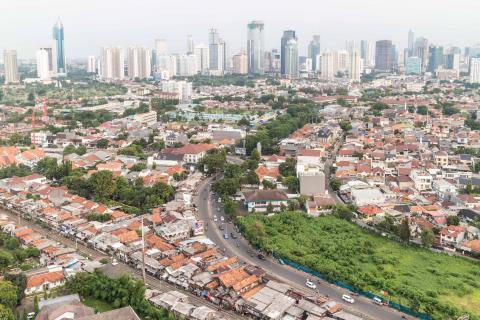Jakarta, Indonesia

Residential area right in the center of Jakarta, the capital city of Indonesia.© Shutterstock
Jakarta, with 9.6 million inhabitants in 2010 and an estimated 10.2 million in 2014, is the largest city of Indonesia and its capital. Jakarta is located in a lowland area with a relatively flat topography in the delta of several rivers, the main one being the Ciliwung River. Due to its naturally flood-prone location, the city has a long history of both coastal and riverine flooding.
Jakarta’s tropical climate is characterized by year-round high temperatures of 24-33°C. The city has frequent high intensity, short duration storms, especially in the afternoons and evenings. The highest observed precipitation total for a single month in Jakarta is more than 800 mm (31.5 inches).The city is also a growing, economically active city. The GDP projections for Indonesia as a whole show overall growth rates of 4.5% per year between the periods 2005 and 2030, and the population of Jakarta is expected to grow from 8.8 million to up to 25 million by 2025.
Key Challenges
The mean annual temperature in Indonesia increased by ca. 0.3°C over the course of the 20th century and the average annual rainfall decreased by ca. 2-3% across Indonesia. However, extreme rainfall events will increase in severity and frequency in the 21st Century. In addition, in South East Asia tropical cyclones are predicted to increase in intensity, which could lead to increased storm surge heights.
Sea level rise is currently taking place at a rate of ca. 1-3 mm (0.04-0.12 inches) per year in coastal areas of Asia, and is projected to accelerate in the future. However, the rapid rates of land subsidence play a more prominent role in relative sea level change: recent estimates suggest an average subsidence rate of 40 mm (1.6 inches) per year in Jakarta and in some places in northern Jakarta up to 20cm subsidence per year. This is likely due to the high volume of groundwater extraction from the middle and lower aquifers, with secondary contributions by building/construction loading and natural consolidation of sedimentary layers.
The high population growth is likely to further intensify the already severe land use pressures that play a role in flooding. Jakarta faces competing interests for land use and other issues causing land encroachment, such as informal settlement, where buffer areas for flood protection are needed.
Priority Area for intervention
The city’s priorities are adaptation to climate change and increasing social inclusiveness.
Resilience Building Effort
Through the Spatial Plan 2030, Jakarta Water Management Strategy 2030 and Climate Adaptation Road Map for 2030, Jakarta aims to promote a safe and sustainable city. A key element is prevention or reduction of annual floods, which are caused by sea-level rise, storm surges and land subsidence, but also by insufficient flow and infiltration capacity of Jakarta’s watercourses (due to illegal waste disposal clogging and insufficient blue-green networks). This is why Jakarta launched the Socially Inclusive Climate Adaptation for Urban Revitalization Project (USD1.3 billion to be invested over 2012-2017) that aims to relocate close to 400,000 illegal squatters from riverbanks and nearby reservoirs, within "a humanized and participative process". Jakarta already succeeded in implementing most of its pilot project around the Pluit Reservoir in North of Jakarta.
As part of the pilot project, the Government of Jakarta has already built 14,201 new apartment units towards the target of 52,656 units by 2017 and relocated around 50,000 people to government subsidised high-rise low-cost housing, while not only providing them with basic amenities (electricity, water), but also taking into account their job security through an economic empowerment scheme. This allowed Jakarta to expand and deepen the Pluit Reservoir to increase its water storage capacity and develop surrounding green spaces to improve water infiltration. The project also delivers multiple co-benefits, including improved livelihood and sanitary conditions for relocated citizens, carbon sequestration and urban pollution reduction. Finally, reduced flood frequency and duration coupled with less people living in flood-prone areas helps prevent disease outbreaks, such as malaria and typhus.
The Government’s success in addressing initial residents’ opposition to the project is largely based on the community multi-stakeholder approach, with leadership from the Governor, officials, private sector and community heads, as well as intensive communication and public information campaigns. These campaigns had to address in particular the issue of residents not being accustomed to living in rented vertical housing and reluctance to relocate without compensation fuelled by lack of knowledge about new housing’s benefits. Another reason for success was the private-public scheme, in which private companies holding property development permits in the affected area were obliged to participate in the project under a cross-subsidy scheme.
“… The approach to the community and community development has become the main focus of the government in order to deal with flooding. Although establishing cooperation in order to overcome the flooding is undeniably crucial, the cooperation itself should be carefully planned and executed to avoid being a burden to the government and community. Furthermore, sharing knowledge and cooperation development at local, regional and international level is urgently needed in order to overcome the issue of floooding.”
- Ir. Basuki Tjahaja Purnama - Mayor of Jakarta, MM (Vice Governor of Jakarta)
